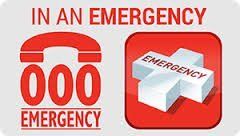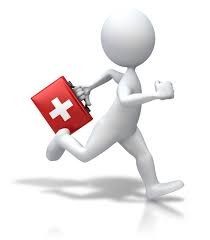CarePlus Health HubFirst Aid in the Home
On this page, you’ll find a wealth of information and professional advice regarding First aid in the home. First aid is one of the most important skills anyone can learn. It may save a life or prevent permanent injury. Below will give some advice for a few common events. To learn more about first aid, enrol in a first aid course with a registered training organisation.


DRABCD Action Plan
St. John Ambulance recommends using their DRABCD Action Plan in assessing whether an injured person has any life-threatening conditions and if immediate first aid is needed.
Minor Cuts & Grazes
- Clean the wound thoroughly with clean (preferably sterile) water or saline solution.
- Apply a sterile dressing; put pressure on the wound to stop bleeding and elevate the area. A pharmacist can advise on appropriate dressings.
- A cut is longer than 1cm – it may require stitches.
- The wound is very dirty.
- There is something imbedded in the wound.
- There is severe bleeding.
D – check for danger
- To you, others and the injured person
R – check response
- Is the injured person conscious or unconscious?
A – check airway
- Is airway clear of objects?
- Is airway open?
- Is chest rising or falling?
- Can you hear or feel air from mouth or nose?
- If no breathing, give 2 initial breaths.
C – give CPR
- If no signs of life – unconscious, not breathing and not moving, start CPR.
- CPR involves giving 30 compressions on lower half of breastbone, at a rate of approximately 100 compressions per minute, followed by 2 breaths.
D –apply a defibrillator (if available)
- Follow voice prompts
Head Injury
- Monitor person’s breathing and pulse.
- Support person’s head and neck during movement in case spine is injured.
- Place a sterile dressing over the wound to control bleeding – apply direct pressure to wound unless you suspect a skull fracture.
- Lie person down with head and shoulders slightly raised. If person vomits, turn them onto their side and clear the airway.
- Phone 000 for an ambulance.
You should seek medical help urgently if person:
- Vomits.
- Is drowsy, less alert or unconscious.
- Develops unusual behaviour.
- Develops a headache.
- Has blood or fluid leaking from their ears.
- Has blurred vision or pupils that are unequal in size.
Important
If a person is unconscious, or needs emergency medical care, phone
000 for an ambulance and follow
DRABCD. If on a mobile outside the network coverage area, dial 112.
Attend a first aid course run by a Registered Training Organisation, such as St. John Ambulance or the Australian Red Cross.
Burns & Scalds
- Remove person from danger.
- Cool burnt area with cold running water for at least 20 minutes.
- Remove clothing and jewellery from burnt area, unless stuck to the burn.
- Place sterile, non-stick dressing over burn – a pharmacist can advise on appropriate dressings.
- Apply fat, lotion or ointment to burns.
- Use towels, cotton wool or blankets directly to the burn.
- Remove anything stuck to a burn.
- Touch burnt areas or burst any blisters.
- The burn involves the airway.
- The burn involves hands, face, feet or genitals.
- The burn is deep, even if the casualty does not feel any pain.
- You are unsure of the severity of the burn.
- A superficial burn is larger than a 20-cent piece.
Choking
Adult/child over 1 year
- Encourage person to relax, breathe deeply and cough to remove object.
- If unsuccessful – phone 000 for an ambulance.
- Bend person well forward and give up to 5 sharp back blows (with heel of hand) between their shoulder blades. Check if obstruction has been relieved after each blow.
- If blockage has not cleared after 5 back blows – place one hand in the middle of the person’s back for support, place the heel of the other hand in the CPR position on the chest and give 5 chest thrusts – slower but sharper then CPR compressions. Check if obstruction has been relieved after each chest thrust.
- If blockage has not cleared after 5 chest thrusts – continue alternating 5 back blows with 5 chest thrusts until medical aid arrives.
- If person becomes unconscious, remove and visible obstruction and commence CPR.
Basic First Aid Kit
- Sterile cotton gauze swabs to clean wounds.
- Assorted sterile adhesive dressing strips.
- Assorted non-stick wound/island dressings.
- Stretch roller bandage.
- Crepe bandage.
- Triangular bandage.
- Safety pins or clips.
- Rust resistant scissors.
- Rust resistant tweezers.
- Sterile normal saline solution.
- Antiseptic.
- Isopropyl alcohol swabs.
- Sting neutraliser.
- Cold or ice pack.
- Disposable gloves.
Infant under 1 year
- Phone 000 for ambulance.
- Place infant on your forearm, with head downwards and support head and shoulders on your hand.
- Hold infant’s mouth open with your fingers and give up to 5 sharp back blows between shoulders with heel of your hand. Check if obstruction has been relieved after each back blow.
- If blockage has not cleared after 5 back blows – place infant on back on a firm surface, place 2 of your fingers on lower half of breastbone (in CPR position) and give 5 chest thrusts – slower but sharper than CPA compressions. Check if obstruction has been relieved after each chest thrust.
- If blockage has not cleared after 5 chest thrusts – continue alternating 5 back blows with 5 chest thrusts until medical aid arrives.
- If infant becomes unconscious, commence CPR.
Poisoning
- Follow DRABCD.
- Phone 000 for ambulance (and fire brigade if atmosphere is contaminated with gas or smoke).
- Listen to the casualty – provide reassurance but not advice.
- Try to determine the type, amount and time of poisoning.
- Phone the Poisons Information Centre on 13 11 26.
DO NOT INDUCE VOMITING.
|
|
|
| St. John Ambulance Australia | Website: www.stjohn.org.au |
|---|---|
| Healthdirect Australia | Phone: 1800 022 222 Website: www.healthinsite.gov.au |
| Consumer Medicine Information (CMI) | Your pharmacist can advise on CMI leaflets |
| National Prescribing Services (NPS) Medicines Information | Phone: 1300 MEDICINE (1300 633 424) Website: www.nps.org.au |
| The Poisons Information Centre | In case of poisoning phone 13 11 26 from anywhere in Australia |
|
|
|
Health Joke




